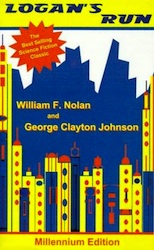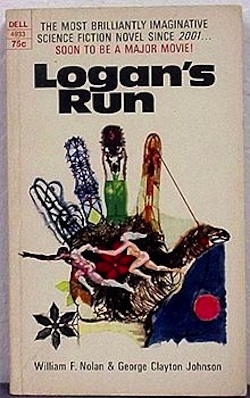Calling Peter Ustinov’s appearance in Logan’s Run a “memorable performance” might be pushing it a little bit. When Logan and Jessica encounter him in the ruins of Washington D.C. the crazy old man rambles about cats for nearly five hours. My favorite part of this rant is when he claims all cats have three names; a regular name, a fancy name, and name only the cat itself knows. While totally bonkers, this little philosophy sort of sums up how the world thinks about Logan’s Run. Everyone knows about the movie (the cat’s regular name). Some people know about the TV show and comics (the cat’s fancy name). But few seem to have read the book!
And even though talking about Logan’s Run elicits mostly snickers and spoofs, the source material is actually worth a serious look because it presents one of the more colorful and interesting dystopias in SF literature.
Written by George Clayton Johnson and William F. Nolan, Logan’s Run is primarily concerned about the baby boom and youth culture of the 1960s. It presents a fairly preposterous “what if” premise about the growing number of 21-year-olds rapidly out numbering everyone else. In the film, the ageist government makes sure everyone’s “last day” is their 30th birthday, but in the book it’s 21. If you saw the movie before you read the book (which is the case for a lot of us) the narrative is suddenly colored in a totally different way. It’s almost like Lord of the Flies meets the classic Trek episode “Miri.” But if you’re willing to go with this premise, the notion of everyone willfully dying so young is pretty terrifying.
 Everything about the novel Logan’s Run is far richer than the film. Logan and Jessica do not escape from secluded dome cities out into a post-apocalyptic wilderness. Instead, the entirety of the world is intact and interconnected by a series of complex underground tunnels that can be traversed at high speeds. The robot Box that taunts Logan and Jessica in the film about “fish, plankton and protein from sea” isn’t a silly silver guy intent on freezing them, but rather a sadistic cyborg that is into kinky torture. Logan’s sidearm is also full of surprises, a kind of revolver that has numerous functions beyond just “stun” and “kill.”
Everything about the novel Logan’s Run is far richer than the film. Logan and Jessica do not escape from secluded dome cities out into a post-apocalyptic wilderness. Instead, the entirety of the world is intact and interconnected by a series of complex underground tunnels that can be traversed at high speeds. The robot Box that taunts Logan and Jessica in the film about “fish, plankton and protein from sea” isn’t a silly silver guy intent on freezing them, but rather a sadistic cyborg that is into kinky torture. Logan’s sidearm is also full of surprises, a kind of revolver that has numerous functions beyond just “stun” and “kill.”
The concepts of youthful energy as an oppressive science fiction concept is doubled through the exploration of a drug called “muscle.” Like its name implies, “muscle” makes you temporarily a whole lot stronger, but naturally, it also makes you totally crazy. As in the film, Logan has to fight off some “cubs”(delinquents) that are pumped up on muscle and as a result super dangerous. In fact, all the action sequences, whether they come in the form of chases or fights, have a page-turning quality that I think would give a lot of modern thriller writers a run for their money. During a summer about ten years ago, I passed around my copy of Logan’s Run amongst three of my closest friends. Everyone finished the book in less than four days. Lazy blurbs call certain books “a romp” or a “wild ride,” but Logan’s Run is just a really, really great read.
The sexual promiscuity explored in the film, is present in the novel in slightly more creative ways. Being a voyeur is viewed as kind of a sport in this world, which serves to hint at even kinkier activities likely lurking just beneath the surface. Not that it distracts from the plot in any kind of weird or creepy way. As in the film, the reader somehow buys that Logan and Jessica like each other a lot and having them on the run together is still fairly romantic.
Perhaps the most surprising thing about Logan’s Run the novel is its ending. From here on out I will seriously spoil the book for you, so if want to read it and really enjoy it, stop reading right here. RETRO SPOILERS BEGIN!
Okay. So throughout the novel, there is a competing narrative that chronicles someone who is following Logan and Jessica throughout their adventures. You’re led to believe that this is Francis for most of the book. But at the very end, it turns out Francis is secretly the legendary Old Man known as Ballard. It’s a bit of a Scooby-Doo moment, but it is sort of great when someone the reader is considering to be an antagonist, turns out to be a good guy. This is a far cry from an old man rambling about cats. What Ballard reveals however is probably the biggest difference between the original Logan’s Run novel and the film. Remember all that stuff in the movie about Sanctuary and how “THERE IS NO SANCTUARY?” Well, in the book, there is a sanctuary. And it’s in space. This moment presents the ultimate fake-out because the authors go out of their way to tell you right at the beginning that humanity isn’t interested in space travel! And then Logan and Jessica end the book by getting on a spacehip! Logan’s Run has all sorts of twists! RETRO SPOILERS END.
Perhaps the most insightful aspect of Logan’s Run is it’s extremely lenghty dedication page in which the authors reference everyone from Doc Savage to Ernest Hemingway. If there was ever a doubt that Logan’s Run wasn’t serious literature, you’ll think twice after reading this list. George Clayton Johnson and William F. Nolan wrote an awesome page-turner which is mostly remembered a kitschy 70s film. Here’s hoping a remake finally happens.
Ryan Britt is a staff blogger for Tor.com. He is constantly threatening to dress up as Logan 5 for Halloween, but always ends up going with his usual stand by costume, the crazy Cat Guy.










